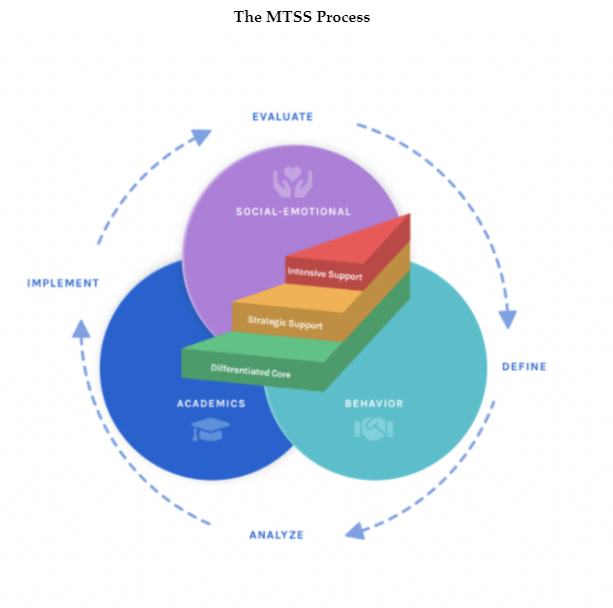MTSS (Multi-Tiered System of Supports)
Multi-Tiered Systems of Support (MTSS) for Families
MTSS (Multi-Tiered System of Supports) is a multi-tiered framework that promotes school improvement through engaging, research-based academic and behavioral practices.
A multi-tiered system of support (MTSS) consists of six critical components.
Leadership
The principal, assistant principal(s), and school leadership team:
- Communicate a vision and mission to school staff.
- Provide resources for planning and implementing instruction and intervention.
- Ensure that staff have the data needed for data-based problem solving.
- Engage staff in ongoing professional development for implementing MTSS.
- Plan strategically for MTSS implementation.
- Model a problem-solving process for school improvement.
Building the Capacity/Infrastructure for Implementation
School-wide capacity and infrastructure include:
- Ongoing professional development and coaching with an emphasis on data-based problem solving and multi-tiered instruction and intervention.
- Scheduling that allows staff to plan and implement targeted instruction and systems of support.
- Processes and procedures for engaging in data-based problem solving.
Communication and Collaboration
- Includes stakeholders in planning and providing continuous feedback.
- Builds the infrastructure to communicate and work with families and other community partners.
- Increases the likelihood that innovative practices will be implemented and sustained.
Data-Based Problem Solving
-
- Includes the use of data-based problem solving for student outcomes across content areas, grade levels, and systems of support.
- Includes the use of problem-solving to address barriers to school-wide implementation of MTSS.
While several models for data-based problem solving exist, the four-step problem-solving approach includes:
- Identifying the goals and objectives to be attained,
- Identifying possible reasons why the desired goals are not being attained,
- Developing a plan for implementing evidence-based strategies to attain goals,
- Evaluating the effectiveness of the plan.
Three-Tiered Instructional/Intervention Model
-
- Tier 1 includes the differentiated Core support all students receive during classroom instruction that utilizes research-based best practices for all learners.
- Tier 2 includes supplemental systems and supports that allow for targeted instruction provided to students not yet meeting benchmarks.
- Tier 3 includes intensive systems and supports that allow for targeted, intensive instruction for students showing significant barriers to learning the skills required for school success.
The three-tiered instructional/intervention model includes both academic and social-emotional/behavioral instruction and systems.
Data Evaluation
- School staff understands and has access to data sources that address the purposes of assessment.
- Procedures and protocols for administering assessments and data use allow school staff to use student data to make educational decisions.
- Data on the fidelity of MTSS implementation allow school leadership to examine the current practices and make changes for improving MTSS implementation.
If you have questions about the MTSS process in your child’s school, please reach out to your child’s school principal. They may answer your question or will direct your question to the school-based MTSS Chair. You can also find helpful info through NCDPI MTSS resources.



